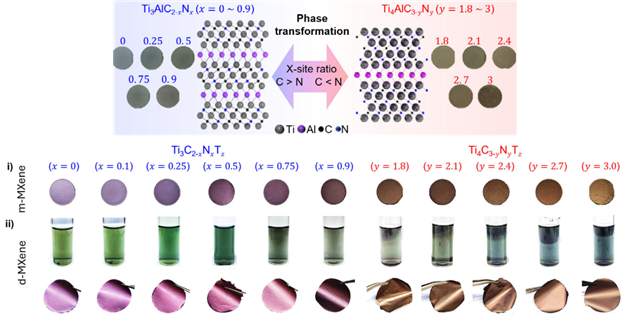Reviewed by Lexie CornerJun 2 2025
A research team has reported the first successful synthesis of high-purity, tunable nitrogen (N)-substituted MAX precursors and resulting MXene two-dimensional (2D) materials. Their findings were published in Advanced Materials.
 (Top) Schematic illustration and photographs of cold-pressed pellets of XSS MAX phases. (Bottom) Photograph of synthesized XSS MXenes showing: i) cold-pressed multi-layered MXene (m-MXene), ii) delaminated MXene (d-MXene) solution (top) with a vacuum-filtrated free-standing film (bottom). Image Credit: Unist
(Top) Schematic illustration and photographs of cold-pressed pellets of XSS MAX phases. (Bottom) Photograph of synthesized XSS MXenes showing: i) cold-pressed multi-layered MXene (m-MXene), ii) delaminated MXene (d-MXene) solution (top) with a vacuum-filtrated free-standing film (bottom). Image Credit: Unist
MXenes are a class of 2D nanomaterials composed of alternating layers of metal and carbon. They are known for their high electrical conductivity and versatile chemical properties, which make them promising for a wide range of applications.
In particular, MXenes are attracting attention as lightweight, ultrathin materials for shielding against electromagnetic interference (EMI), especially in the sub-terahertz (sub-THz) range. Compared to conventional metallic shields, which are heavy, prone to corrosion, and less effective at high frequencies, MXenes offer better high-frequency shielding with reduced weight and thickness.
Most MXenes developed so far have been carbon-based. However, theoretical studies suggested that replacing some carbon atoms with nitrogen could further enhance their physical and chemical properties. Previous attempts to achieve this substitution were limited by synthesis challenges. This study overcame those obstacles by partially replacing carbon in the MAX precursors with nitrogen, using a titanium-based synthesis method. The resulting MXene materials showed improved performance.
The N-substituted MXene films, which are only about 5–10 micrometers thick - roughly one-tenth the thickness of a human hair - demonstrated an electrical conductivity of 35,000 S/cm. This is the highest reported value for MXenes to date and contributes to their strong EMI shielding capability.
The method also allows precise control over the level of nitrogen substitution, from 0% to nearly 100%, while maintaining a single-crystal structure free of impurities. This tunability enables fine adjustments to the material’s electromagnetic properties, making it suitable for various high-frequency and EMI-related applications.
N-substituted MXenes represent a groundbreaking advancement in next-generation electromagnetic shielding technology. They have the potential to significantly reduce electromagnetic interference across a wide range of fields - from mobile devices and automotive or aerospace electronic systems to advanced communication infrastructure.
Soon-Yong Kwon, Professor, Graduate School of Semiconductor Materials and Devices Engineering, Ulsan National Institute of Science & Technology
This study was supported by the Nano Material Technology Development Program of Korea's National Research Foundation (NRF), which is financed by the Ministry of Science and ICT (MSIT).
Journal Reference:
Han, J.-H. et al. (2025) Ultrahigh Conductive MXene Films for Broadband Electromagnetic Interference Shielding. Advanced Materials. doi.org/10.1002/adma.202502443